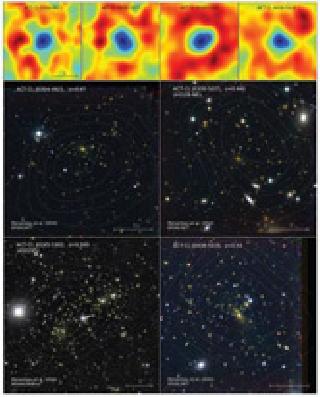
Four ACT images of cosmic background radiation, top row, with dark blue colors indicating "shadows" cast by galaxy clusters. Below, four optical images of the galaxy clusters, with white contour lines corresponding to the cosmic background radiation intensity levels in the ACT images. Photo: Tobias Marriage, Johns Hopkins / Princeton; Felipe Menanteau, Rutgers.
NEW BRUNSWICK, NEW JERSEY (BNS): An international team of scientists led by Rutgers University astrophysicists has discovered 10 new massive galaxy clusters from a large, uniform survey of the southern sky.
The survey was conducted using a breakthrough technique that detects "shadows" of galaxy clusters on the cosmic microwave background radiation, a relic of the "big bang" that gave birth to the universe.
The research began in 2008 with the help of a new radio telescope, known as the Atacama Cosmology Telescope (ACT). The ACT collects millimeter-length radio waves that reveal images of the otherwise invisible cosmic background radiation.
"The groundbreaking observations at Atacama, led by Lyman Page of Princeton University, surveyed large areas of the sky to reveal shadows that pointed astronomers to these previously unseen massive galaxy clusters," Felipe Menanteau, a research scientist in physics and astronomy, School of Arts and Sciences, at Rutgers, was quoted as saying in the Rutgers University news report.
The higher sensitivity and resolution of ACT has made it practical for astronomers to essentially reverse the procedure – to search the cosmic background radiation for shadows that indicate the presence of unseen clusters.
"The 'shadows' that ACT revealed are actually the hot gases within the galaxy clusters cause a tiny fraction of the cosmic background radiation to shift to higher energies, which then makes them appear as shadows in one of ACT’s observing band," said Jack Hughes, professor of physics and astronomy at Rutgers.
Hughes and Menanteau worked with Chilean professors Leopoldo Infante and Felipe Barrientos to collect optical images of dozens of candidates, which led to the discovery of ten entirely new massive galaxy clusters. The Rutgers and PUC team, which also included PUC undergraduate student Jorge González, worked on two optical telescopes in Chile over the course of seven nights during October and December of 2009, added the news report.
 Previous Article
Previous Article Next Article
Next Article











The Indian Air Force, in its flight trials evaluation report submitted before the Defence Ministry l..
view articleAn insight into the Medium Multi-Role Combat Aircraft competition...
view articleSky enthusiasts can now spot the International Space Station (ISS) commanded by Indian-American astr..
view article